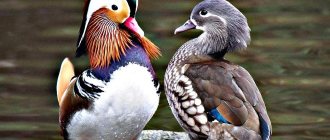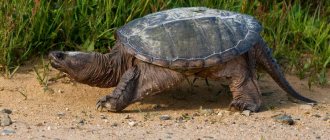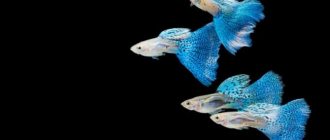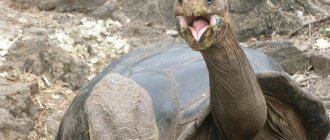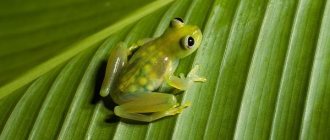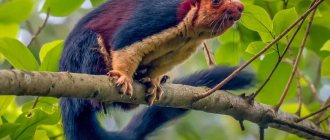Turtles are the most unusual and oldest reptiles in the world. They are unique in their own way, because they are able to survive even in the harshest, unbearable conditions. Many of them perfectly adapt to sudden temperature changes, others – to high temperatures.
Certain subspecies are distinguished by incredible vitality: they can live without food and water for several decades. There are representatives that survive without oxygen for 10 hours or more.
The size of the reptiles evokes special admiration. This rating presents only the world's largest representatives of reptiles in terms of size and weight.
snapping turtle
Compared to other giants on the list, this representative is small in size. The length of such an animal does not exceed 35 cm, weight – about 14 kg. Certain individuals reach a weight of 30 kilograms.
The species is distributed in Canada, the eastern and central United States. Animals prefer to live near ponds with silt. Such features help turtles survive in winter: they simply bury themselves in it during the cold weather. In winter they hibernate.
This species is resistant to cold and is able to move both under and on ice. They feed on small animals of the underwater world, carrion. These turtles are the target of many poachers. Their meat is a highly delicacy product that is prized among local residents.
How to warm the shore
The temperature on the island is 30-35 degrees comfortable for animals. They control it with a thermometer. The lamp should be placed so that the turtle does not get burned from it. If you have several pets, you should know that they can climb on top of each other and get warm at the same time. In this case, the lamps are installed higher. It is also worth remembering that when turtles get into the water, splashes fly, so the lamp is covered to prevent water from entering. Turn on the heating for 10-12 hours.
The lamp should be taken with UV rays. They buy it at a pet store. Without UV rays, the animal will not be able to absorb calcium, will begin to get sick and will become ugly.
A few photo examples of an aquarium for turtles:
Pond slider
A representative of freshwater animals, common in America and Mexico. Females significantly exceed males in size. Thus, the length of their shell can reach 37 cm, in males it is only 20 cm.
The turtle got its name due to the presence of red spots on the sides of its head. Individuals prefer to live in swampy, dirty reservoirs. They lead a very sedentary lifestyle. Very sensitive: in the presence of danger, they quickly react and quickly hide.
Turtles easily adapt to life in captivity. They require proper care. In comfortable conditions they can live up to half a century in captivity.
How to keep your animal healthy
Most often, diseases occur due to poor care and feeding. Be sure to monitor the cleanliness of the water, because various microbes can develop in the water, affecting the health of the animal. To keep your pet healthy you need to:
- Sick pets are kept at a temperature of 27-30 degrees. At this time, it will be better if he spends most of the time in the water.
- If your pet is a poor swimmer, lower the water level in the aquarium. But keep in mind that she should easily crawl ashore.
- If you suspect an infection, isolate your pet. Wash your hands well after handling it.
- If you doubt that you can cure your pet, contact your veterinarian.
Fringed appearance
A member of the snake-necked family. Such turtles are distinguished by their peculiar appearance and bizarre features.
They have a large, triangular head, a nose that resembles a long process, and a thin and long neck. The animal's shell is called a carapace - it looks like a pyramid with growths. Its length can reach 40 cm, the weight of an adult is 15 kg.
Some residents call these turtles “matamata”. The species is most common in South America, Brazil and Peru. To live, animals choose bodies of water with stagnant water and feed exclusively on fish. In an ideal environment they can live up to 75 years.
Spur-bearing individual
The largest land turtle. The shell of an individual can reach up to 75 cm. According to some information, individuals often reach 1 meter in shell length. Females weigh about 60 kg, males - 100 kg.
Such amphibious giants live in the Sahara deserts. These are mainly herbivores that can go without water for a long time. They are characterized by rapid growth.
In captivity they can live up to 50 years. Recently, the number of turtles has sharply decreased. This is due to hunting of the species for meat.
Record holder among freshwater specimens
The largest among freshwater reptiles is the snapping (alligator) turtle. The largest turtle (photo in the article) weighs about 75 kilograms with a body length of 140 cm.
Characteristics:
- eats fish;
- habitat - USA (southeast);
- life expectancy - on average 60 years (under favorable conditions they live up to 80);
- reptile is an active hunter;
- They look terrifying in appearance: a large head with a pointed nose, similar to a beak, and unpleasant pimply skin.
It should be noted that the appearance of this turtle is not the worst thing about it. She is very aggressive and can even bite or seriously injure. Therefore, in America it was forbidden to breed it at home.
Green turtle
Opens the top three. Its length can be about 150 cm, weight - 200 kg. On average, animals of the species live up to 80 years. It is called so because of its specific olive color.
Sometimes dark brown individuals are also found. They live in the Pacific and Atlantic oceans. The species is often called soup, since meat is often used in the preparation of such a dish.
Due to active hunting, the species is on the verge of extinction and is protected by law. Catching such animals is strictly prohibited.
Turtle habitat in the wild
Reptiles live alone, meeting with fellow animals only to reproduce. The toad-headed subspecies reacts aggressively to its relatives during the mating season. Red-eared sliders courtship by removing algae from their partner's shell.
Life expectancy depends on where the turtle lives. Human pets live longer than wild animals. In the wild, on average, reptiles live up to 30 years. There are turtles that live in nature for a long time.
Leatherback turtle
Record holder among reptiles. Its length reaches 2 meters, and its weight is 600 kg. Therefore, such individuals are rightfully considered the largest turtles in the world. With such sizes, their life expectancy is short - reaches 20-30 years. Turtles of this species are listed under the protection of the Red Book because they are becoming extinct.
The species is even listed in the Book of Records. A representative of the species Archelon had a length of 4 meters and weighed about 2 tons. This animal is considered the largest reptile that was once known to the world.
Since childhood, we have all been familiar with the most ancient representative of the fauna - the turtle. But most of us know only about some species of this amazing animal. Some parents bought this funny creature (an ordinary land turtle) as a pet as a child, while others keep these amphibians in aquariums along with fish (a small red-eared turtle).
There are approximately 230 species of turtles in the world. In science they are divided into families and suborders. Since their appearance on Earth (more than 220 million years ago), turtles have remained virtually unchanged in appearance. Some of them are so unusual that it is worth talking about in more detail.
A rather rare species found today in Southeast Asia. The spiny turtle chooses swampy water bodies to live. The shields of the shell located along its edges are pointed and serve as protection from enemies. Due to its unusual shape, from a distance the turtle can be confused with a withered leaf. This feature helps the animal camouflage itself among fallen leaves. The turtle's diet is varied - from plant foods to small invertebrates. She is not averse to eating pieces of raw meat.
Unlike its relatives, this turtle has a soft shell. But this is not the only feature of the animal. When studying this species in more detail, scientists discovered two oddities:
- 94% of the soft-shelled turtle's urine output occurs through the mouth. The remaining 6% exits through the cloaca.
- Despite the fact that the turtle breathes with its lungs, it has the amazing ability to stay under water for up to an hour and a half or more without harming its health.
In China and other East Asian countries, the meat of this turtle is an exquisite delicacy. In China alone, several farms have been organized to raise soft-bodied turtles for culinary purposes. They supply up to 90 million individuals to the market annually. But the demand for such culinary delights is so great that the soft-shelled turtle may soon disappear from the face of the Earth.
This turtle can only be found in the river called Mary (Australia) - hence its name. Among all representatives of its genus, the Mary River turtle holds the record for the size of its tail, which can reach 2/3 of the entire body length. The shell of adult individuals has an elongated shape. Its color can be pink, red, brown and even black.
Turtles reach sexual maturity only at 25-30 years of age (females are ready to reproduce earlier). The animal spends the main part of its life under water, occasionally emerging to the surface to take a breath of air through its mouth (breathing is mainly carried out through the cloaca). As the turtle ages, its body becomes overgrown with colorful algae, which helps it camouflage itself from river predators.
Turtles of this species are distributed throughout North America - from southern Canada to northern Mexico. Unlike her Australian relative, the American can be proud of her long nose. The turtle's head has the shape of a triangle, and the round, smooth and flat shell is covered with black spots, which, as they grow older, first turn pale and later disappear altogether.
From a distance, the soft shell of a turtle looks absolutely smooth, but in fact it is literally studded with small tubercles and spines, which serve as protection for the animal from enemies. The long-nosed beauty lives in reservoirs; its main diet consists of insects, but occasionally it is not averse to eating small fish. The turtle is ready for reproduction at 8-10 years old, life expectancy is about 50 years.
Eastern long-necked turtle
Many animals live in glass containers: turtles, fish, lizards and crustaceans. Home terrariums usually contain a terrestrial species of turtles, from which freshwater and land animals emerge.
Reptiles with webbed swimming limbs. Most aquatic turtle species inhabit bodies of water with low water movement. Mobile carnivorous reptiles, but herbivorous species are also found.
red-eared
Brown-green turtle. Also called . It lives in shallow ponds in Mexico, South and Central America and Africa. It got its name because of the red spots in the ear area; there are species with bright yellow spots. There are rich green stripes on the head and paws. Young individuals are less intensely colored than mature ones. The carapace (upper part of the shell) of females is up to 30 cm, in males - up to 15 cm, there are claws. The diet of young individuals is dominated by animal food. Sedentary and non-conflict pets.
Trionix Chinese or Far Eastern
Turtles up to 20 cm in size with a soft leathery shell. The nose is oblong in the form of a trunk. These three-toed inhabitants of Asian reservoirs are very active and aggressive. They can injure a person with sharp plates located on their jaws. To keep these predators at home, a newborn individual is purchased. included in the Red Book and prohibited for sale. It is caught by smugglers and supplied to stores.
Caspian
Omnivorous turtles with a flat oval shell up to 30 cm in length. The color consists of alternating yellow and green stripes. Individuals love salty or fresh water with a temperature of 18–22 degrees and a large amount of vegetation near the reservoir. Found in Southern Europe and Central Asia. In nature, they climb high into the mountains. They live for 30 years. In this species of freshwater turtle, sexual differences are clearly visible: the tail of males is more powerful and longer, the carapace is concave.
Silt loggerhead
Aquarium turtles with a small shell up to 18 cm and a disproportionately large body. Though harmless in appearance, reptiles are capable of injuring with their false teeth. They come from North and South America. They live in shallow streams and swamps with abundant vegetation. A container of 60–100 liters is suitable for keeping at home. They feed on animal food and dry food.
European marsh
Dark green turtles up to 35 cm. The body is covered with light spots. A large and long tail, webbed feet and sharp claws. Reptiles live near lakes and ponds. listed in the Red Book. Kept at an air temperature of about 30 degrees.
Types of small
According to the scientific classification, small turtles are considered freshwater species, the average size of which does not exceed 13 cm. A terrarium with a capacity of 100 liters is suitable for pets.
Three-keel
Small reptiles up to 13 cm. Color from reddish-brown to black, carapace with three keels. Easy to care for, an aquarium up to 100 liters is suitable. They inhabit the countries of South Asia and lead a completely land-based lifestyle in forests. They are omnivores, eat fruits and vegetables, and are not averse to eating fish. In some countries they are prohibited for home keeping.
musky
Turtles get their name from the musk glands under their shells. The length of the oval carapace is 7–13 cm. There are light inclusions on the dark head and carapace. Young turtles are distinguished by three longitudinal ridges on the carapace, which disappear over the years. They feed on mollusks, insects, and small fish. Range: Canada to South America. In the natural environment, they are the orderlies of the reservoir. Turtles swim well; the terrarium should have an island and a pond.
Spotted
Amphibious pets up to 12 cm in length. The carapace is black, without projections. Light yellow spots are evenly distributed on the shell, head and limbs. There are also color variations with orange and reddish splashes. They live at room temperature. For convenience, place shelters in a glass container and aquatic plants in a pond. The turtle is diurnal. Diet type: insectivores. Juveniles feed exclusively on animal food. Plants are rarely eaten. In nature, they live in marshy and damp areas.
Pond Reeves
A turtle with a shell length of 13 cm. The carapace is colored brown. There are olive, gray-green and black body colors, with yellow stripes. Females are lighter than males and have a shorter tail. Temperatures not lower than 22 degrees are allowed. It is known that turtles can survive freezing temperatures.
Closing
Domestic turtles are endowed with a peculiarity: in case of danger, the gap between the plastron and the carapace closes. The genus of closures consists of species:
- reddish mud turtle;
- mud red-cheeked;
- mud walleye;
- musk common;
- musky keel.
Flat
The carapace of these 9-centimeter turtles is slightly extended forward and has a slight convexity. Color ranges from olive to brown depending on the breed. The forelimbs have scales and 4 or 5 toes. The muzzle is oblong. Females are larger than males. Carnivorous species, eats fish, mice and shrimp.
Description of red-eared turtles and species
Red-eared slider photo
Red-eared turtles are born with a shell length of only 30 mm and have a very attractive bright color. In the first 1.5 years, the turtle reaches a size of 75 mm. After which the growth rate decreases and on average the growth is 10 – 15 mm per year. Individuals are characterized by the presence of distinct red or yellow-red spots on both sides of the head. The shell and skin are olive, olive-brown or green with yellow stripes. The shape of the shell is oval. Legs with large claws and membranes between the toes.
This species cannot be classified as ornamental, since the average size of the freshwater red-eared turtle is from 125 to 289 mm, however, there are records of individuals reaching a size of 350 mm. In the wild, the red-eared turtle lives for about 20 years; in captivity, it can even live up to 40 years.
Over time, the turtle's large size and lifespan embarrass buyers, who are unable to keep the turtles in captivity for long periods of time and release them into the wild.
Trachemys scripta elegans.
Red-eared slider photo
The length of the carapace of Trachemys scripta elegans reaches 280 mm. There is a wide red stripe on the head and narrow stripes on the chin. On each costal carapace there is a transverse yellow stripe. Plastron with a large spot on each scute.
Trachemys scripta scripta.
Red-eared slider photo
The length of the carapace of Trachemys scripta scripta reaches 270 mm. There is a yellow postorbital spot on the head, connected to a stripe on the neck. Each costal carapace has a yellow stripe. The plastron is yellow with spots on most of the front scutes.
Trachemys scripta troostii.
Red-eared slider photo
The length of the carapace of Trachemys scripta troostii reaches 210 mm. The head has a narrow yellow postorbital stripe and wide chin stripes. Each costal carapace has a yellow transverse stripe. Plastron with a pattern of “eyes” or small black spots.
Types of land
Central Asian
Popular domestic pet species. At home, they grow up to 10–18 cm. Turtles have a light shell with dark scutes and four-fingered limbs. Once a week you can have a swim. They do not like to be disturbed; they prefer peace and regularity. Provide animals with air at 30 degrees and sandy soil in which they can dig.
Star or Indian
Beautiful pets with an unusual shell shape. The scutes are convex, slightly pointed, with a striking star pattern. The shell is dark, the pattern is yellow. The turtles are medium in size, females reach 25 cm, males - 15 cm. The varieties living in Sri Lanka and South India have 5-7 rays in color. Individuals from northern India have 7–9 thin “star” rays. They eat plant foods.
Mediterranean
Color and maintenance preferences differ among subspecies. The color can be plain or dark with yellow splashes. The front legs of domestic turtles have 5 toes, and the hind legs have spurs. There is a bump of horny tissue on the back of the thigh. Sizes up to 35 cm.
Egyptian
The shell size reaches 12 cm, females are smaller than males. The shell is sand-colored with black spots. They are whimsical in their contents and susceptible to diseases. Herbivores, in nature they feed on plants of the genus Artemisia. Calcium and D3 are added to the diet. The opportunity to determine sex in this species is available at 15 years of age. They are kept in groups of their own species in a spacious tank.
Balkan
The shell size is up to 20 cm. In external features it resembles a Mediterranean turtle. The shell is light brown with a dark pattern. Over the years, the color fades to yellowish-gray. The tail has a horny tip. They feed on peas, beans, clover and fruits. Supplement the diet with slugs and snails. Mobile pets are especially active in the warm season.
What to feed red-eared turtles?
Red-eared turtle diet
Red-eared turtles are omnivores and love to eat a wide variety of plants and animals: filamentous algae, snails, terrestrial insects, crustaceans, small vertebrates, etc.
However, the feeding frequency of turtles varies depending on age. So young turtles are fed daily, but adults only 2-3 times a week.
All young Red-eared turtles are primarily predators, therefore they need live food for active growth, which they are fed once a day (neither 2 nor 3). In addition, the aquarium must contain live plants (algae, lettuce leaves) as plant food. Adult Red-eared turtles (over 7 cm) are fed 3 – 4 times a week, and the amount of plant food approaches 50%.
Proper and nutritious nutrition for red-eared turtles will keep them healthy and playful for many years. The diet of domestic turtles must include plant foods (such as basil, aloe, oregano, peas, balsam, figs, clover, coleus, calendula, nettle, onions, dandelions, petunias, rose petals, barley, rose hips, cyperus, Kalanchoe, fern, hibiscus, lawn grass, coffee, plantain), vitamin and mineral supplements, fish (such as cod, hake, thalassa) and meat.
Red-eared turtle eating
But not all plants are useful for turtles, there are also poisonous ones (monstera, epipremnum, philodendron, anthurium, silent, acalyph, croton, jatrophe, azalea, delphinium, crocus, morning glory, lily of the valley, lupine, periwinkle, oleander, juniper, nightshade, ficus, philodendron, shefflera), some of which cause great harm to health even after touching. In some cases, eating these plants leads to disruption of the nervous system and gastrointestinal tract.
You should not include in the red-eared turtles’ diet such foods as are so familiar to us, such as: meat (minced meat, sausages, beef, pork, lamb, chicken, etc.), fatty fish, fruits, bread and cheese.
Please note that feeding aquarium fish and aquarium turtles must be correct: balanced and varied. This fundamental rule is the key to their successful maintenance.
Currently, dry food is, of course, popular and popular food for fish and turtles. For example, you can find food from Tetra, the leader of the Russian market, on aquarium shelves all the time and everywhere, having a range of food “for every taste.” Tetra’s “gastronomic arsenal” includes individual food for a specific type of fish: guppies, goldfish, cichlids, loricariids, labyrinths, arowanas, discus fish, etc. Tetra has also developed specialized foods, for example, to enhance color, fortified, or for feeding fry. You can find out detailed information about all Tetra feeds on the company’s official website - here .
It would not be amiss to note that when purchasing any dry food, you should first of all pay attention to the date of its manufacture and shelf life, try not to buy food in bulk, and also store the food in a closed state - this will help to avoid the development of pathogenic flora in it .
